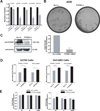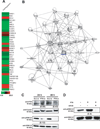PTN signaling: Components and mechanistic insights in human ovarian cancer
- PMID: 25418856
- PMCID: PMC4456343
- DOI: 10.1002/mc.22249
PTN signaling: Components and mechanistic insights in human ovarian cancer
Abstract
Molecular vulnerabilities represent promising candidates for the development of targeted therapies that hold the promise to overcome the challenges encountered with non-targeted chemotherapy for the treatment of ovarian cancer. Through a synthetic lethality screen, we previously identified pleiotrophin (PTN) as a molecular vulnerability in ovarian cancer and showed that siRNA-mediated PTN knockdown induced apoptotic cell death in epithelial ovarian cancer (EOC) cells. Although, it is well known that PTN elicits its pro-tumorigenic effects through its receptor, protein tyrosine phosphatase receptor Z1 (PTPRZ1), little is known about the potential importance of this pathway in the pathogenesis of ovarian cancer. In this study, we show that PTN is expressed, produced, and secreted in a panel of EOC cell lines. PTN levels in serous ovarian tumor tissues are on average 3.5-fold higher relative to normal tissue and PTN is detectable in serum samples of patients with EOC. PTPRZ1 is also expressed and produced by EOC cells and is found to be up-regulated in serous ovarian tumor tissue relative to normal ovarian surface epithelial tissue (P < 0.05). Gene silencing of PTPRZ1 in EOC cell lines using siRNA-mediated knockdown shows that PTPRZ1 is essential for viability and results in significant apoptosis with no effect on the cell cycle phase distribution. In order to determine how PTN mediates survival, we silenced the gene using siRNA mediated knockdown and performed expression profiling of 36 survival-related genes. Through computational mapping of the differentially expressed genes, members of the MAPK (mitogen-activated protein kinase) family were found to be likely effectors of PTN signaling in EOC cells. Our results provide the first experimental evidence that PTN and its signaling components may be of significance in the pathogenesis of epithelial ovarian cancer and provide a rationale for clinical evaluation of MAPK inhibitors in PTN and/or PTPRZ1 expressing ovarian tumors.
Keywords: MAP kinase signaling; PTPRZ1 (protein tyrosine phosphatase receptor Z1); epithelial ovarian cancer (EOC); pleiotrophin (PTN); survival.
© 2014 Wiley Periodicals, Inc.
Conflict of interest statement
Figures





References
-
- Siegel R, Naishadham D, Jemal A. Cancer statistics, 2013. CA: A Cancer Journal for Clinicians. 2013;63(1):11–30. - PubMed
-
- Modugno F, Ness RB, Wheeler JE. Reproductive risk factors for epithelial ovarian cancer according to histologic type and invasiveness. Ann Epidemiol. 2001;11(8):568–574. - PubMed
-
- Morch LS, et al. Hormone therapy and different ovarian cancers: a national cohort study. Am J Epidemiol. 2012;175(12):1234–1242. - PubMed
-
- McCluggage WG. Morphological subtypes of ovarian carcinoma: a review with emphasis on new developments and pathogenesis. Pathology. 2011;43(5):420–432. - PubMed
-
- Ren H, et al. Identification of anaplastic lymphoma kinase as a potential therapeutic target in ovarian cancer. Cancer Res. 2012;72(13):3312–3323. - PubMed
Publication types
MeSH terms
Substances
Grants and funding
LinkOut - more resources
Full Text Sources
Other Literature Sources
Medical

